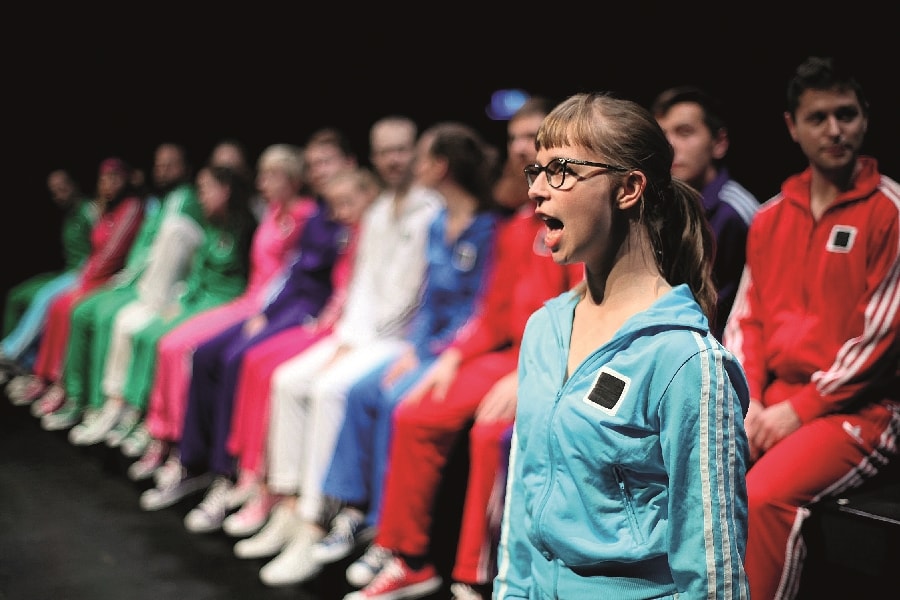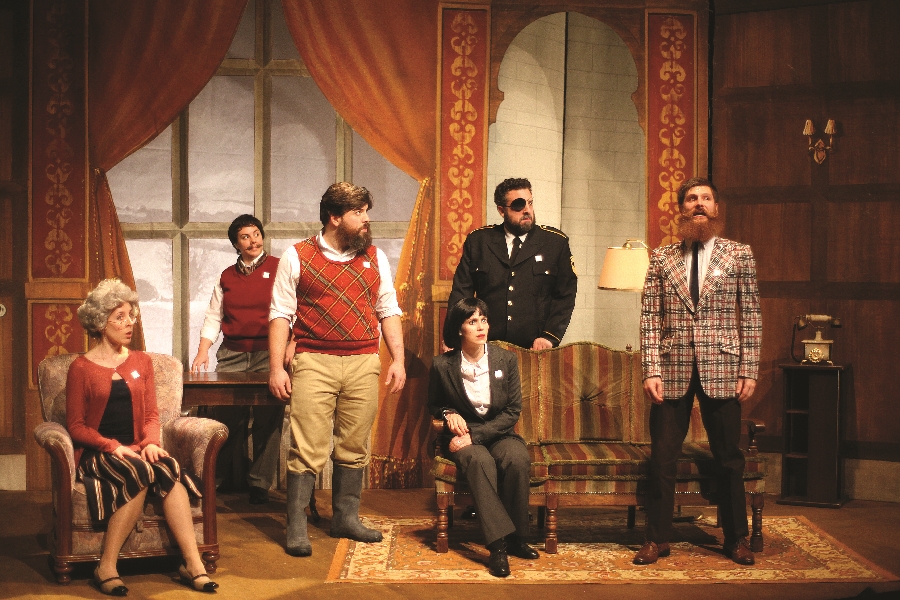If you’ve seen the work of Nature Theater of Oklahoma, you’ve probably had your “wow” moment. Maybe it came while puzzling over five actors stumbling awkwardly around in campy get-ups with bad foreign accents in No Dice. Or perhaps it happened some time in the third hour of the synchronized, Soviet-style calisthenics of Life and Times: Episode 1. Whenever it occurred—if it didn’t send you running from the theatre—it meant that the experiments of this radically adventurous company started to exercise a strange, even obsessive pull on your senses. To paraphrase one enthralled fan, NTOK is like “a worm in your head” that never stops burrowing.
I caught the bug late in the game, in 2010, when I heard that a New York troupe with a name borrowed from Kafka, known for devising plays by means of chance throws of dice or random card selections, would be performing in an unremarkable Paris suburb. I got there on the Metro, and three-and-a-half hours later I emerged from the French premiere of No Dice (which had already played in New York at the 2007 Under the Radar festival) convinced I’d witnessed some kind of Unidentified Theatre Object.
I had snickered too loudly at the halting delivery of a pirate in Hassidic curls; I couldn’t take my eyes off a transcendental keyboard player in a fur hat and dark shades; when Dr. Pepper and PBJs were served at the intermission, I wondered if I was in Gennevilliers, the East Village, or a galaxy far, far away. What was that?!
A bigger surprise came almost a year later when these alien performers, now with a growing following in Europe, returned to Paris with the first installment of an even more challenging work, Life and Times. But while the scope of that as-yet-uncompleted project, meant for a full day’s viewing, makes a euphemism of “ambitious”—and although what I witnessed quickly divested me of any comfortable assumptions about theatre I might have still harbored—it wasn’t just what I saw onstage that night but a remark its creators made afterward that put a worm in my head.
Like many of the characters they have imagined over the past nine years, Kelly Copper, with her bird’s nest of auburn hair, and Pavol Liska, unmistakable in a handlebar mustache, are scene-stealers in their own right. But actors, like books, are best not judged by their covers. As co-founders and joint artistic directors of Nature Theater of Oklahoma, Copper and Liska take the process of making theatre extremely seriously and convey their ideas with an unflinching sincerity that might sound ironic coming from anyone else. So when, back in New York, I sat down with them during the Soho Rep production of Life and Times: Episode 1–4, presented at the Public Theater’s Under the Radar festival in January, it was with the same guileness that I asked them about one thing that caught my attention when I first met them in Paris—so much so that (to borrow from their penchant for gambling with outcomes) it changed the stakes for me in how I measure their work: “How is the total revolution in the arts going?”
NTOK is often described by the intellectual company it keeps, from John Cage and Marcel Duchamp to the Wooster Group and Richard Foreman (with whom Liska once interned). To be sure, early works like No Dice and the mute, choreographed Poetics: A Ballet Brut (2005), which launched a concerted assault on the theatre medium, use a language of performance and referentiality inherited from the accumulated searchings of the postmodern age and its preoccupation with representation and narrative. But the Cage-Wooster-Foreman constellation is not an unusual lodestar in the universe of devised theatre, whereas NTOK doesn’t hestitate to shoot the moon.
What keeps Copper and Liska creating every day is what they call a “utopian” quest to make a place for art in life and life in art. In terms of influences, they cite modernist visionaries like James Joyce, Gertrude Stein and the Russian abstract painter Kazimir Malevich, whose Suprematist Manifesto of 1926 called for the rediscovery of “pure feeling in creative art” (and whose geometric symbols are peppered throughout the opening episodes of Life and Times). NTOK has its own dictum: in Liska’s words, “to contribute to the overall mental and emotional health of society,” and, in Copper’s, “to find how art is useful and somehow a part of everyday life” (concepts closer to the community-building of Bread and Puppet Theater than the formalisms of the Wooster Group). This is what they referred to with straight faces as “the total revolution in the arts” when I first spoke to them in Paris. It’s what they are trying, with herculean energy, to bring about in Life and Times.

Such a vast, multi-form work, the end of which is still nowhere in sight,
defies pat summaries and qualifying adjectives (although an insider’s analysis of the whole of NTOK’s work by Life and Times’s dramaturg Florian Malzacher will be published to coincide with the premiere of the show’s next episode). This unfinished epic of American life does not so much build on NTOK’s preceding work as it sketches with graphic strokes the company’s two guiding principles: “exploring the mundane” and “subverting expectations.”
In the interests of both those goals, Liska asked company member Kristin Worrall to record her life story, down to the smallest detail, resulting in hours of minutiae of middle-class suburbia from about 1975 onward. Life and Times spans 10 hours, and was presented in January as separate installments and in a marathon (which included three breaks and came with dinner and snacks). Episode 1 ran 3 hours and 30 minutes (with no intermission), Episode 2 was two hours, and Episodes 3 and 4 clocked in at a total of 2 hours and 30 minutes.
Not only is Worrall’s unedited narration, well, suburban, it is rife with colloquialisms, non-sequiturs and hundreds, eventually perhaps thousands, of likes, ums and uhs.
I—know it sounds crazy, but—
I see myself in the picture,
Even though I’m like—5 minutes—year—year old—um—
Probably more than 5 minutes, but—
Um—and I’m all in like—swaddling clothes—
And I have black hair, and—I’m looking
At the camera, you know—through these squinty eyes—
Operating on the maxim that “if theatre doesn’t have a super-ambitious dimension, it’s not worth doing,” NTOK set this jarringly un-musical language to an original score and added choreography consisting of a series of highly stylized gestures. Then, in case anyone was starting to enjoy this tinned musical, Episodes 3 and 4 take a 180-degree turn. Now the eight actors, who wore identical uniforms earlier and “sang” and “danced” on a blank stage, appear in period costumes on a set à la Agatha Christie’s Mousetrap, and deliver their lines in booming, archly dramatic tones. The focus contracts gradually, like a shrinking vignette in a silent film, so that Episode 4 ends with a single actor almost whispering the text before the lights go out completely, leaving the audience in the dark.
Whether one interprets that phrase literally or figuratively all depends on a perceived experience of the play—in a word, on whether Copper and Liska’s anticipated “revolution” has taken place on some level for the spectator. To get those people in the seats to engage with Life and Times and not just “hold it at arm’s length,” says Copper, she and Liska paid significant attention to how they could enter each of the episodes and follow the narrative through, before making the leap to the challenges of the next one. Copper says she worked particularly hard not to lose the public in the rambling narrative of Life and Times by offering “a thin thread of continuity that the audience can track.”
Of course, so much effort would not be needed if NTOK were telling a traditional story with usual theatrical means. Copper and Liska use an onion metaphor to describe their investigations, the essence of which can only be reached by removing outward peels of plot, character, tension and all the trappings of “theatre.” In the same way, as unlikely as it seems that the verbatim language of Life and Times will uncover any truths about the narrator’s life, it is only the vehicle that was provided to tell that story; remove it and what is left is the ontological process of knowing, or, to paraphrase Gertrude Stein, knowing through the process of “remembering, and hence becoming.”
The best example in the play of this knowledge equation involves a certain geometry of experience derived directly from Malevich. Actors in Episode 1 hold up yellow rings while executing stiff-limbed triangles and squares with their arms, toss shiny red balls at the audience, move in polygon formations across the stage and wear white-rimmed red squares on their gray uniforms where a name tag would go. This cryptic staging may appear facetious and could be dismissed as an insider joke. But Copper and Liska are wholly genuine in their use of this vocabulary of the Suprematist movement that tried, as they do, to access the “zero degree” of the creative act, and that believed in the supremacy of emotion as the source of art.
Watching Life and Times, it’s not necessary to know that the black squares the actors wear pinned to their breasts in Episodes 3 and 4 are Malevich’s symbol of revolution. Yet anyone can sense that these squares and rings and primary colors are elements of the visual plane experienced by the developing senses of a child; if being is the memory of coming to know, those figures are a reminder of the young narrator’s process of remembering her encounter with the physical world and, ultimately, with herself.
Finally, the audacity of NTOK’s commitment to the ordinary material of an uneventful childhood makes Life and Times a saga worthy of sharing. It was another young narrator, Joyce’s Stephen Dedalus, who cleared the way for the self to enter the hallowed halls of literature, when he aspired to “become a priest of life” and to “forge in the smithy of [his] soul the uncreated conscience of [his] race.” Modernist writing dared, as Stein did, to show us (the critic F.W. Dupee wrote) “the sheer magnificence of unmediated reality,” while in Ulysses Joyce transformed a single day in Dublin through the crucible of language into one of the most significant works of literature of the 20th century. To make art from life is essentially the project of Life and Times, and, just as for Modernist literature a century ago, it is an undertaking that is defiantly unclassifiable in its own age.
“All of this is a sociological, spiritual, aesthetic experiment, the whole thing,” Liska has said. “How can we exist together in a room that is constructed like a theatre? The theatre is just an excuse; it’s the other stuff that’s interesting.”
In that light, perhaps Life and Times deals less in the codes of performance than in old-fashioned Aristotelian tragedy. Where are we at the end of Episode 4, indeed? Beckett said it best: Without pity and piety, the human and the divine, we are ever where we were, as we were.
Keeping that worm burrowing, there is more “stuff” to come, in future episodes, which will continue to be developed in Europe. It’s a detail, perhaps, but one that bears mentioning: NTOK’s utopia, like the Modernist paradigm, has found deeper-pocketed patrons abroad than at home. Coming soon to a Continental venue near you, then, there will be an animated film (Episode 4.5), a timed reading of an illuminated book (Episode 5)—both hand-illustrated by Copper and Liska—and a radio play (Episode 6). It promises to be breathtaking and bold. It has, apparently, no limits. It’s just like life should be.
Molly Grogan is a theatre critic, translator and researcher in literature and linguistics.


